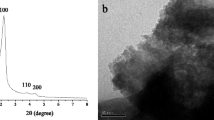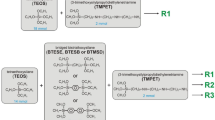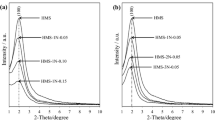Abstract
Mesoporous silicas with chemically attached macrocyclic moieties were successfully prepared by sol-gel condensation of tetraethyl orthosilicate and β-cyclodextrin-silane in the presence of a structure-directing agent. Introduction of β-cyclodextrin groups into the silica framework was confirmed by the results of IR spectral, thermogravimetric, and quantitative chemical analysis of surface compounds. The porous structure of the obtained materials was characterized by nitrogen adsorption-desorption measurements, powder X-ray diffraction, transmission electron microscopy, and dynamic light scattering. It was found that the composition of the reaction mixture used in β-cyclodextrin-silane synthesis significantly affects the structural parameters of the resulting silicas. The increase in (3-aminopropyl)triethoxysilane as well as the coupling agent content in relation to β-cyclodextrin leads ultimately to the lowering or complete loss of hexagonal arrangement of pore channels in the synthesized materials. Formation of hexagonally ordered mesoporous structure was observed at molar composition of the mixture 0.049 TEOS:0.001 β-CD-silane:0.007 CTMAB:0.27 NH4OH:7.2 H2O and equimolar ratio of components in β-CD-silane synthesis. The sorption of alizarin yellow on starting silica and synthesized materials with chemically attached β-cyclodextrin moieties was studied in phosphate buffer solutions with pH 7.0. Experimental results of the dye equilibrium sorption were analyzed using Langmuir, Freundlich, and Redlich-Peterson isotherm models. It was proved that the Redlich-Peterson isotherm model is the most appropriate for fitting the equilibrium sorption of alizarin yellow on parent silica with hexagonally arranged mesoporous structure as well as on modified one with chemically immobilized β-cyclodextrin groups.

Graphical abstract













Similar content being viewed by others
References
Agrawal R, Gupta V (2012) Cyclodextrins—a review on pharmaceutical application for drug delivery. Intern J Pharm Frontier Res 2:95–112
Alahmadi SM, Mohamad S, Maan MJ (2014) Organic-inorganic hybrid materials based on mesoporous silica MCM-41 with β-cyclodextrin and its applications. Asian J Chem 26:4323–4329
Aoyagi T, Nakamura A, Ikeda H, Ikeda T, Mihara H, Ueno A (1997) Alizarin Yellow-modified β-cyclodextrin as a guest-responsive adsorption change sensor. Anal Chem 69:659–663
Bai Z-W, Lai X-H, Chen L, Ching C-B, Ng S-C (2004) Arylcarbamoylated allylcarbamido-β-cyclodextrin: synthesis and immobilization on nonfunctionalized silica gel as a chiral stationary phase. Tetrahedron Lett 45:7323–7326
Belyakov VN, Belyakova LA, Varvarin AM, Khora OV, Vasilyuk SL, Kazdobin KA, Maltseva TV, Kotvitskyy AG, Danil de Namor AF (2005) Supramolecular structures on silica surfaces and their adsorptive properties. J Coll Int Sci 285:18–26
Belyakova LA, Besarab LN, Roik NV, Lyashenko DY, Vlasova NN, Golovkova LP, Chuiko AA (2006) Designing of the centers for adsorption of bile acids on a silica surface. J Colloid Interface Sci 294:11–20
Belyakova LA, Kazdobin KA, Belyakov VN, Ryabov SV, Danil de Namor AF (2005) Synthesis and properties of supramolecular systems based on silica. J Coll Int Sci 283:488–494
Bibby A, Mercier L (2003) Adsorption and separation of water-soluble aromatic molecules by cyclodextrin-functionalized mesoporous silica. Green Chem 5:15–19
Cai K, Li J, Luo Z, Hu Y, Hou Y, Ding X (2011) β-Cyclodextrin conjugated magnetic nanoparticles for diazepam removal from blood. Chem Commun 47:7719–7721
Chen L, Zhang L-F, Ching C-B, Ng S-C (2002) Synthesis and chromatographic properties of a novel chiral stationary phase derived from heptakis(6-azido-6-deoxy-2,3-di-O-phenylcarbamoylated)-β-cyclodextrin immobilized onto aminofunctionalized silica gel via multiple urea linkages. J Chromatogr A 950:65–74
Chong ASM, Zhao XS (2003) Functionalization of SBA-15 with APTES and characterization of functionalized materials. J Phys Chem B 107:12650–12657
Concheiro A, Alvarez-Lorenzo C (2013) Chemically cross-linked and grafted cyclodextrin hydrogels: from nanostructures to drug-eluting medical devices. Adv Drug Deliv Rev 65:1188–1203
Dittert LW, Higuchi T (1963) Rates of hydrolysis of carbamate and carbonate esters in alkaline solution. J Pharm Sci 53:852–857
Dodziuk H (2006) Cyclodextrins and their complexes: chemistry, analytical methods, applications. Weinheim, Wiley-VCH
Eguchi M, Du Y-Z, Taira S, Kodaka M (2005) Functional nanoparticle based on β-cyclodextrin. NanoBiotechnology 1:165–169
Feng Y-Q, Xie M-J, Da S-L (2000) Preparation and characterization of an L-tyrosine-derivatized β-cyclodextrin-bonded silica stationary phase for liquid chromatography. Anal Chem Acta 403:187–195
Fujimura K, Ueda T, Ando T (1983) Retention behavior of some aromatic compounds on chemically bonded cyclodextrin silica stationary phase in liquid chromatography. Am Chem Soc 55:446–450
Gabbott P (2008) Princciples and applications of thermal analysis. Blackwell, Oxford
Gidwani B, Vyas A (2015) A comprehensive review on cyclodextrin-based carriers for delivery of chemotherapeutic cytotoxic anticancer drugs. Biomed Res Int 2015:1–15
Glajch JL, Kirkland JJ, Köhler J (1987) Effect of column degradation on the reversed-phase high-performance liquid chromatographic separation of peptides and proteins. J Chromatogr A 384:81–90
Gong Y, Lee HK (2003) Application of cyclam-capped β-cyclodextrin-bonded silica particles as a chiral stationary phase in capillary electrochromatography for enantiomeric separation. Anal Chem 75:1348–1354
Grun M, Unger KK, Matsumoto A, Tsutsumi K (1997) Ordered mesoporous MCM-41 adsorbents: novel routes in synthesis, product characterization and specification. In: McEnaney B, Mays JT, Rouquerol J, Rodriguez-Reynoso J, KSW S, Unger KK (eds) Characterisation of porous solids IV. The Royal Society of Chemistry, London, pp 81–89
Hegeson RC, Timko JM, Cram DJ (1973) Structural requirements for cyclic ethers to complex and lipophilize metal cations or alpha-amino acids. J Amer Chem Soc 95:3023–3025
Helfferich FG (1995) Ion exchange. Dover, New York
Hug R, Marcier L (2001) Incorporation of cyclodextrin into mesostructured silica. Chem Mater 13:4512–4519
Kaasalainen M, Aseyev V, von Haartman E, Sen Karaman D, Makila E, Tenhu H, Rosenholm J, Salonen J (2017) Size, stability, and porosity of mesoporous nanoparticles characterized with light scattering. Nanoscale Res Lett 12:74–83
Katz E, Eksteen R, Schoenmakers P, Miller N (eds) (1998) Handbook of HPLC—chromatographic science series. Marcel Dekker Inc., New York
Kawaguchi Y, Tanaka M, Nakae M, Funazo K, Shono T (1983) Chemically bonded cyclodextrin stationary phases for liquid chromatographic separation of aromatic compounds. Am Chem Soc 55:1852–1857
Kim T-W, Chung P-W, Lin VS (2010) Facile synthesis of monodisperse spherical MCM-48 mesoporous silica nanoparticles with controlled particle size. Chem Mater 22:5093–5104
Kirkland JJ, Glajch JL, Farlee RD (1989) Synthesis and characterization of highly stable bonded phases for high-performance liquid chromatography column packing. Anal Chem 61:2–11
Korenman IM (1970) Photometric analysis. Methods of determination of organic compounds. Khimia, Moscow (in Russian)
Kruk M, Jaroniec M (1999) Characterization of highly ordered MCM-41 silicas using x-ray diffraction and nitrogen adsorption. Langmuir 15:5279–5284
Kruk M, Sacamoto Y, Terasaki O, Ryoo R, Ko CH (2000) Determination of pore size and pore wall structure of MCM-41 by using nitrogen adsorption, transmission electron microscopy, and X-ray diffraction. J Phys Chem B 104:292–301
Lai X, Ng S-C (2003) Mono(6A-N-allylamino-6A-deoxy)perphenylcarbamoylated β-cyclodextrin: synthesis and application as a chiral stationary phase for HPLC. Tetrahedron Lett 44:2657–2660
Lala R, Thorat A, Cargote CS (2011) Current trends in β-cyclodextrin based drug delivery systems. IJRAP 2:1520–1526
Larkin P (2011) Infrared and Raman spectroscopy: principles and spectral interpretation. Elsevier, Oxford
Lehn JM (1978) Cryptates: inclusion complexes of macropolyciclic receptor molecules. Pure Appl Chem 50:871–892
Lehn J-M (1995) Supramolecular chemistry: concepts and perspectives. Weinheim, VCH Verlagsgesellschaft
Li C, Song X, Hein S, Wang K (2010) The separation of GMP from milk whey using the modified chitosan beads. Adsorption 16:85–91
Li M, Tarawally M, Liu X, Liu X, Guo L, Yang L, Wang G (2013) Application of cyclodextrin-modified gold nanoparticles in enantioselective monolith capillary electrochromatography. Talanta 109:1–6
Liu C, Naismith N, Economy J (2004b) Advanced mesoporous organosilica materials containing microporous β-cyclodextrin for the removal of humic acid from water. J Chromatogr A 1036:113–118
Liu J, Alvarez J, Kaifer AE (2000) Metal nanoparticles with a Knack for molecular recognition. Adv Mater 12:1381–1383
Liu M, Da S-L, Feng Y-Q, Li L-S (2005a) Study on the preparation method and performance of a new β-cyclodextrin bonded silica stationary phase for liquid chromatography. Anal Chim Acta 533:89–95
Liu M, Li L-S, Da S-L, Feng Y-Q (2005b) High performance liquid chromatography with cyclodextrin and calixarene macrocycle bonded silica stationary phases for separation of steroids. Talanta 66:479–486
Liu Y, Han B-H, Zhang HY (2004a) Spectroscopic studies on molecular recognition of modified cyclodextrins. Curr Org Chem 8:35–46
Mondjinou YA, McCauliff LA, Kulkarni A, Paul L, Hyun S-H, Zhang Z, Wu Z, Wirth M, Storch J, Thompson DH (2013) Synthesis of 2-hydroxypropyl-β-cyclodextrin/pluronic-based polyrotaxanes via heterogeneous reaction as potential niemann-pick type C therapeutics. Biomacromolecules 14:4189–4197
Nakanishi K (1962) Infrared adsorption spectroscopy—practical. Holden-Day, Inc., Tokyo; Nankodo Company Ltd. San Francisco
Palaniappan A, Li X, Tay FEH, Li J, Su X (2006) Cyclodextrin functionalized mesoporous silica films on quarts crystal microbalance for enhanced gas sensing. Sensors Actuators B 119:220–226
Pan BC, Xiong Y, Su Q, Li AM, Chen JL, Zhang QX (2003) Role of amination of a polymeric adsorbent on phenol adsorption from aqueous solution. Chemosphere 51:953–962
Patel P, Deshpande A (2014) Patent review on cyclodextrin based nanosponges prepared by different methods: physicochemical characterization, factors influencing formation and applications. World J Pharm Sci 2:380–385
Patil A, Chirmade UN, Trivedi V, Lamprou DA, Urquhart A, Douroumis D (2011) Encapsulation of water insoluble drugs in mesoporous silica nanoparticles using supercritical carbon dioxide. J Nanomedic Nanotechnol 2:1–8
Pedersen CJ (1967) Cyclic polyethers and their complexes with metal salts. J Amer Chem Soc 89:2495–2496
Phan TNT, Bacquet M, Laureyns J, Morcellet M (1999) New silica gels functionalized with 2-hydroxy-3-methacryloyloxypropyl-β-cyclodextrin using coating or grafting methods. Phys Chem Chem Phys 1:5189–5195
Phan TNT, Bacquet M, Morcellet M (2000) Synthesis and characterization of silica gels functionalized with monochlorotriazinyl β-cyclodextrin and their sorption capacities towards organic compounds. J Incl Phenom Macrocycl Chem 38:345–359
Roik NV, Belyakova LA (2013) Sol-gel synthesis of MCM-41 silicas and selective vapor-phase modification of their surface. J Solid State Chem 207:194–202
Roik NV, Belyakova LA (2011) Interaction of supramolecular centers of silica surface with aromatic amino acids. J. Colloid Interface Sci 362: 172–179
Sagliano N Jr, Hartwick RA, Patterson RE, Woods BA, Bass JL, Miller NT (1988) Stabilization of reversed phases for liquid chromatography: application of infrared spectroscopy for the study of bonded-phase stability. J Chromatogr A 458:225–240
Salis A, Casula MR, Bhattacharyya MS, Pinna M, Solinas V, Monduzzi M (2010) Physical and chemical lipase adsorption on SBA-15: effect of different interactions on enzyme loading and catalytic performance. Chem Cat Chem 2:322–329
Schneiderman E, Stalcup AM (2000) Cyclodextrins: a versatile tool in separation science. J Chromatogr B 745:83–102
Seleim MM, Abu-Bakr MS, Hashem EY, El-Zohry AM (2009) Simultaneous determination of aluminum (III) and iron (III) by first-derivative spectrophotometry in alloys. J Appl Spectrosc 76:554–563
Shpigun OA, Ananieva IA, Budanova NY, Shapovalova EN (2003) Use of cyclodextrins for separation of enantiomers. Russ Chem Rev 72:1035–1054
Shvets O, Belyakova L (2015) Synthesis, characterization and sorption properties of silica modified with some derivatives of β-cyclodextrin. J Hazard Mat 283: 643−656.
Staab HA (1962) Syntheses using heterocyclic amides (azolides). Angew Chem Int Ed Engl 1:351–367
Steed JW, Atwood JL (2009) Supramolecular chemistry. Wiley, New York
Stuart BH (2004) Infrared spectroscopy: fundamentals and applications. Wiley, Chichester
Szejtli J (1998) Introduction and general overview of cyclodextrin chemistry. Chem Rev 98:1743–1753
Tiwari G, Tiwari R, Rai AK (2010) Cyclodextrins in delivery systems: applications. J Pharm Bioallied Sci 2:72–79
Unger KK (1979) Porous silica—its properties and use as support in column liquid chromatography. Elsevier, Amsterdam
Xu X, Liu Z, Zhang X, Duan S, Xu S, Zhou C (2011) β-Cyclodextrin functionalized mesoporous silica for electrochemical selective sensor: simultaneous determination of nitrophenol isomers. Electrochim Acta 58:142–149
Yano H, Hirayama F, Arima H, Uekama K (2001) Preparation of prednisolone-appended α-, β- and γ-cyclodextrins: substitution at secondary hydroxyl groups and in vitro hydrolysis behaviour. J Pharm Sci 90:493–503
Yoshida N, Fujimoto M (1982) Proton-transfer reactions of 5-(m- and p-nitrophenylazo)salicylic acids coupled with inclusion reactions with α- and β-cyclodextrins. Bull Chem Soc Jpn 55:1039–1045
Zhang L-F, Wong Y-C, Chen L, Ching CB, Ng S-C (1999) A facile immobilization approach for perfunctionalised cyclodextrin onto silica via the Staudinger reaction. Tetrahedron Lett 40:1815–1818
Funding information
We received no funding for this study.
Author information
Authors and Affiliations
Corresponding author
Ethics declarations
Competing interests
The authors declare that they have no competing interests.
Rights and permissions
About this article
Cite this article
Roik, N.V., Belyakova, L.A., Trofymchuk, I.M. et al. Mesoporous silicas with covalently immobilized β-cyclodextrin moieties: synthesis, structure, and sorption properties. J Nanopart Res 19, 317 (2017). https://doi.org/10.1007/s11051-017-3999-z
Received:
Accepted:
Published:
DOI: https://doi.org/10.1007/s11051-017-3999-z




